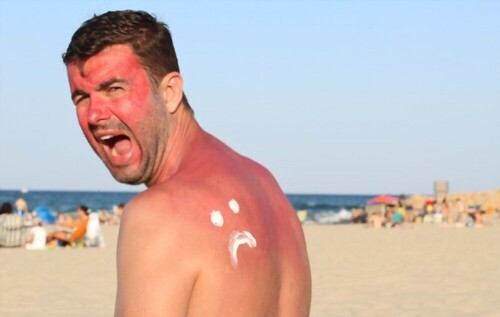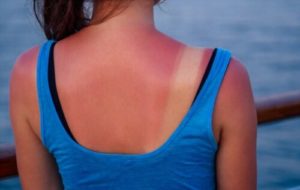 So summer finally arrived, you rushed to the beach, park, back garden or foreign destination but were unprepared for the intense UV rays and now find yourself with red, painful sunburn. Even when you take the appropriate action and apply sun protection regularly or even take steps to limit direct sun exposure and sit in the shade, accidents can still happen. Many people fail to realise that concrete, glass, water and sand all reflect the sun’s rays so sitting in the shade doesn’t mean that you’re not still being subjected to UV exposure. Maybe you underestimated the power of the sun on a cloudy day and didn’t know that clouds don’t offer much protection against UV rays. Perhaps you were also unaware that when you are in the water, the skin is exposed to both direct and reflected rays, or that these rays can also penetrate through the water. The cooling effect of water also makes it difficult to know when your skin is starting to burn.
So summer finally arrived, you rushed to the beach, park, back garden or foreign destination but were unprepared for the intense UV rays and now find yourself with red, painful sunburn. Even when you take the appropriate action and apply sun protection regularly or even take steps to limit direct sun exposure and sit in the shade, accidents can still happen. Many people fail to realise that concrete, glass, water and sand all reflect the sun’s rays so sitting in the shade doesn’t mean that you’re not still being subjected to UV exposure. Maybe you underestimated the power of the sun on a cloudy day and didn’t know that clouds don’t offer much protection against UV rays. Perhaps you were also unaware that when you are in the water, the skin is exposed to both direct and reflected rays, or that these rays can also penetrate through the water. The cooling effect of water also makes it difficult to know when your skin is starting to burn.
What is Sunburn?
Sunburn is your body’s inflammatory response to damage caused by overexposure of ultraviolet (UV) rays to the skin’s outer layer, the epidermis. Simply put, it’s a radiation burn, which sounds much more scary than plain old sunburn! The amount of sunburn that you experience is controlled by the amount of melanin the body produces. Melanin is the substance which the gives the skin its pigmentation. In response to UV exposure the body produces more melanin to absorb the UV light and help defend the DNA of the cells, which ultimately turns the skin darker – the so-called suntan. Genetics determine how much melanin the body produces, and those with light skin, freckles, blue eyes, or red or blonde hair usually produce less. If enough melanin is not produced to combat the UV exposure, cellular damage to the skin occurs which causes the condition called solar erythema, more commonly known as sunburn.
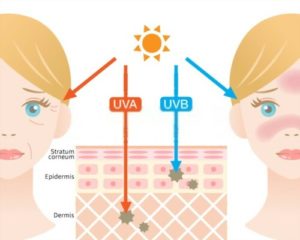 There are three types of UV radiation generated by the sun – UVA, UVB and UVC. UVA rays penetrate deeper into the skin and the photons, the particles which transmit light, interact with the skin, and can impact the sites where new skin cells are generated and damage the skin’s proteins and membranes. Thus, these type of rays are linked to long-term skin damage such as premature ageing, for example wrinkles and saggy skin, although it is also acknowledged that they may play a part in some skin cancers.
There are three types of UV radiation generated by the sun – UVA, UVB and UVC. UVA rays penetrate deeper into the skin and the photons, the particles which transmit light, interact with the skin, and can impact the sites where new skin cells are generated and damage the skin’s proteins and membranes. Thus, these type of rays are linked to long-term skin damage such as premature ageing, for example wrinkles and saggy skin, although it is also acknowledged that they may play a part in some skin cancers.
UVB rays are the ones which cause the sunburn reaction, and they make up approximately just 5% of the sun’s rays. They penetrate the skin on a more superficial level, only affecting the top layers, but they are higher energy than UVA rays and the photons are absorbed by the DNA of the top layer of skin cells, preventing the DNA from linking up correctly and subsequently triggering self-destruction of some of these cells.
When the top cells of the skin, called keratinocytes, detect the DNA damage within themselves they put out an SOS call to the immune system by producing molecules to attract immune cells. This also causes the skin’s blood vessels to leak into any spaces between the cells and other skin structures, and its this extra fluid which causes the swelling and redness associated with sunburn.
Although the immune cell invasion may start while you are sitting on the beach it can continue for the next 24-48 hours which is why sunburnt skin may get progressively worse despite no further sun exposure. During the immune cell invasion, the skin cells in self-destruct-mode are rejected and chemicals are also released into the skin, which can cause an allergic reaction in some people, making the skin itch.
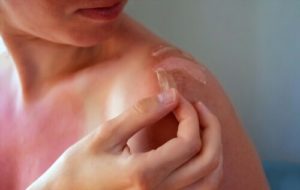 In more severe cases of cell destruction, entire layers of keratinocytes have been destroyed, and as the layer of dead skin is rejected and pushed away from the lower layers, the vacant space is filled with fluid, presenting as blisters. Meanwhile melanin starts to settle over the skin cells to protect against further damage, which is why the skin goes brown when the redness subsides. The lower layer of skin cells start to grow quickly to replace the dead layer which is then dispelled to make way for the new cells, and thus the skin starts to peel.
In more severe cases of cell destruction, entire layers of keratinocytes have been destroyed, and as the layer of dead skin is rejected and pushed away from the lower layers, the vacant space is filled with fluid, presenting as blisters. Meanwhile melanin starts to settle over the skin cells to protect against further damage, which is why the skin goes brown when the redness subsides. The lower layer of skin cells start to grow quickly to replace the dead layer which is then dispelled to make way for the new cells, and thus the skin starts to peel.
Lastly, UVC rays are filtered by the earth’s atmosphere and only a tiny percentage reach the skin’s surface, although those that do are absorbed by the skin’s outer dead cells and do not reach the living cells.
How to treat sunburn
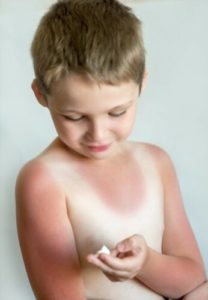
- It may be obvious but get out of the sun immediately, and avoid any further exposure until any redness subsides which may take a few days, or even a week or more for severe sunburn.
- Take cool (not cold) or lukewarm showers or baths, but do not remain in the water too long as this will dry the skin out more. Add a moisturiser whilst the skin is still damp (see below natural suggestions). Pat the skin dry, do not rub. Alternatively, soak a towel and lay it over the affected area.
- Apply a product to reduce inflammation and irritation (see below natural suggestions).
- Drink plenty of fluids. Since a burn draws fluid to the skin’s surface, it can cause dehydration as it takes fluid from other parts of the body. Sports drinks to replenish electrolytes may also be beneficial.
- Wear loose clothing in a breathable fabric such as cotton.
- Avoid using products with synthetic perfume or alcohol which can irritate the skin more.
- Do not put petroleum jelly on sunburn whilst it is hot – it will trap in the heat and make it “cook” more.
- Do not put ice or an ice-pack directly on the burnt skin (wrap in a towel first or make a cold compress).
- Take over the counter pain relief if required.
- If you feel dizzy, faint, feverish, nauseous, confused, or develop chills or a severe headache, seek immediate medical attention.
- Do not pop blisters. You can cover blisters in a vulnerable position with a wound dressing to prevent them ripping and also to stop infection. If the blisters are large or cover a large amount of the body, seek immediate medical attention as sunburn can be equivalent to a 2nd or 3rd degree burn and can lead to infection, skin loss, and scarring.
- Do not pull any loose, peeling skin, you may rip off more than intended, and can cause scarring.
Soothe your sunburn
Avoid synthetic creams and lotions, filled with chemicals, fragrance and alcohol which can irritate the skin further, and even cause an allergy on the sensitised skin. Ingredients ending with “caine” such as benzocaine are to be avoided in particular since they are known to cause an allergic reaction. When the skin is at its most vulnerable, it makes sense to heal it with gifts from Nature. Let’s take a quick look at some of the natural solutions available:
Aloe Vera
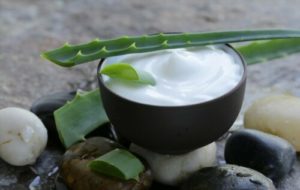 Aloe vera is probably the most well-known and popular remedy for sunburn and is a key ingredient in most aftersun treatments, and for very good reason. It is a natural light moisturiser with remarkable hydrating properties, and studies have demonstrated that it can penetrate up to three epidermal layers of the skin, in addition to penetrating the epidermis quicker than water. It instantly soothes and cools sunburn due to a pain relieving compound called carboxypeptidase, whilst mucopolysaccharide compounds help to bind moisture into the skin. Polysaccharides also actively stimulate skin repair and rejuvenation, and aloe vera has been shown to increase skin repair by up to eight times. Studies have shown that another compound, aloinsin, helps to prevent the skin peeling which can happen following sunburn. In addition to soothing the pain, aloe vera also reduces swelling, promotes circulation and inhibits bacteria. The results of four controlled clinical trials on actual burns including 371 patients concluded that the healing time for those being treated with aloe vera was 8.79 days shorter, and therefore it shouldn’t surprise you to know that aloe vera is nicknamed the “burn” plant. Aloe vera has been confirmed by the Skin Cancer Foundation as a safe remedy for the relief of mild sunburn.
Aloe vera is probably the most well-known and popular remedy for sunburn and is a key ingredient in most aftersun treatments, and for very good reason. It is a natural light moisturiser with remarkable hydrating properties, and studies have demonstrated that it can penetrate up to three epidermal layers of the skin, in addition to penetrating the epidermis quicker than water. It instantly soothes and cools sunburn due to a pain relieving compound called carboxypeptidase, whilst mucopolysaccharide compounds help to bind moisture into the skin. Polysaccharides also actively stimulate skin repair and rejuvenation, and aloe vera has been shown to increase skin repair by up to eight times. Studies have shown that another compound, aloinsin, helps to prevent the skin peeling which can happen following sunburn. In addition to soothing the pain, aloe vera also reduces swelling, promotes circulation and inhibits bacteria. The results of four controlled clinical trials on actual burns including 371 patients concluded that the healing time for those being treated with aloe vera was 8.79 days shorter, and therefore it shouldn’t surprise you to know that aloe vera is nicknamed the “burn” plant. Aloe vera has been confirmed by the Skin Cancer Foundation as a safe remedy for the relief of mild sunburn.
Essential Oils
Essential oils can also help to treat sunburn naturally. They contain anti-inflammatory, antibacterial, antiseptic and antifungal properties, and can help to improve skin quality, impart analgesic or cooling affects, boost skin repair, and even give a glow to dry, parched skin. Add a few drops to a carrier oil (after the heat of the burn has started to subside), or to your favourite natural lotion to turn your everyday toiletries into an effective aftersun agent, or add to aloe vera to increase the benefits. You can also add a few drops to a bath product or some epsom salts to provide extra therapeutic benefits with your cooling bath.
Peppermint Essential Oil
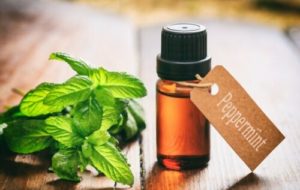 When you’re burnt to a crisp and your skin feels like it’s on fire, peppermint with its analgesic, cooling and numbing properties is a sure-fire winner. Peppermint, thanks to its high menthol content, stimulates cold receptors on the skin and dilates blood vessels, which is what causes that cooling sensation. The therapeutic properties of peppermint include anti-inflammatory and antiseptic, and it acts as an antihistamine to relieve itching, swelling and redness associated with the sunburn or an accompanying heat rash, and prevents infection. Furthermore, peppermint accelerates wound healing and supports regeneration of the skin. It can also soothe a headache caused by the heat or too much sun.
When you’re burnt to a crisp and your skin feels like it’s on fire, peppermint with its analgesic, cooling and numbing properties is a sure-fire winner. Peppermint, thanks to its high menthol content, stimulates cold receptors on the skin and dilates blood vessels, which is what causes that cooling sensation. The therapeutic properties of peppermint include anti-inflammatory and antiseptic, and it acts as an antihistamine to relieve itching, swelling and redness associated with the sunburn or an accompanying heat rash, and prevents infection. Furthermore, peppermint accelerates wound healing and supports regeneration of the skin. It can also soothe a headache caused by the heat or too much sun.
Eucalyptus Essential Oil
Similar to Peppermint, Eucalyptus also contains menthol but in smaller amounts, and is maybe better suited for more sensitive skin. It’s cooling, pain-numbing and anti-inflammatory properties will help to numb and soothe the pain and discomfort from sunburn in no time. It also has antibacterial properties to protect against infection, and can help to alleviate a rash and headache.
Frankincense Essential Oil
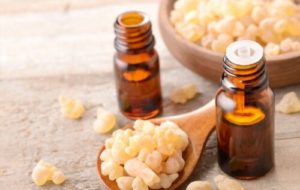 Frankincense is renowned for its anti-inflammatory and skin regenerating properties. Packed with antioxidants, and naturally cooling, the powerful purifying properties of frankincense oil make it effective for soothing the skin. It enhances the protective function of the epidermis whilst soothing and nourishing affected areas of the skin. Frankincense prevents infection, stimulates cell renewal and accelerates wound healing. Sunburnt skin is uncomfortable and painful but this oil is able to block the production of inflammatory chemicals that cause swelling, and reduce pain by interacting with opioid receptors to prevent the brain receiving messages regarding pain and subsequently increasing the pain threshold.
Frankincense is renowned for its anti-inflammatory and skin regenerating properties. Packed with antioxidants, and naturally cooling, the powerful purifying properties of frankincense oil make it effective for soothing the skin. It enhances the protective function of the epidermis whilst soothing and nourishing affected areas of the skin. Frankincense prevents infection, stimulates cell renewal and accelerates wound healing. Sunburnt skin is uncomfortable and painful but this oil is able to block the production of inflammatory chemicals that cause swelling, and reduce pain by interacting with opioid receptors to prevent the brain receiving messages regarding pain and subsequently increasing the pain threshold.
Chamomile oil
Chamomile has been used for centuries for its soothing and calming properties. A powerful antioxidant and anti-inflammatory with the ability to increase wound healing, it is a staple herbal remedy to diminish a number of skin ailments, and is able to reduce redness, swelling and pain, and restore inflamed skin, making it a great remedy to soothe painful sunburn.
Lavender Essential Oil
Lavender is well known for its sedative and calming effects, but as a jack-of-all-trades, is equally as effective for the skin, and has been used for years for its beneficial skin healing and calming effects. It is a superb antioxidant to protect the skin, calms inflammation and promotes healing. It also has antibacterial effects, and as one of the mildest essential oils available is suitable for even the most sensitive of skins.
Sandalwood gel
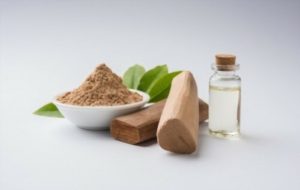 Sandalwood contains cooling properties and can be used to calm inflammation, and soothe the redness, itching and pain associated with sunburn. An effective antioxidant, it promotes skin recovery and rejuvenation, and is also a broad-spectrum antiseptic. Sandalwood moisturiser dry skin, and restores and increases the skin’s ability to retain moisture. Furthermore, it prevents abnormal pigmentation, delays the skin’s tanning process to allow for a more even tan, and effectively acts as a brightening and lightening agent to give a natural radiance and glow to the skin.
Sandalwood contains cooling properties and can be used to calm inflammation, and soothe the redness, itching and pain associated with sunburn. An effective antioxidant, it promotes skin recovery and rejuvenation, and is also a broad-spectrum antiseptic. Sandalwood moisturiser dry skin, and restores and increases the skin’s ability to retain moisture. Furthermore, it prevents abnormal pigmentation, delays the skin’s tanning process to allow for a more even tan, and effectively acts as a brightening and lightening agent to give a natural radiance and glow to the skin.
Note
Sunburnt skin is highly sensitive and requires maximum care. Whilst natural products are the best solution for effective healing with minimal damage to the skin such as scarring and hyper-pigmentation, natural healing is not going to happen overnight. Do not over apply essential oils to try to enhance healing and speed up the process as this can aggravate the skin further.
Prevention Is the Best Medicine
 Every time you burn your skin you increase your risk of skin cancer, with childhood sunburns significantly increasing the risk. But you can still lessen your chance of developing skin cancer by taking even greater care of the skin cells which are already more vulnerable. Just to be clear, you often hear people complaining about windburn too but there is no such thing. Certainly wind can dry out the skin and cause chapping, but it does not make it burnt – that’s sunburn where the UV intensity was disguised by the wind.
Every time you burn your skin you increase your risk of skin cancer, with childhood sunburns significantly increasing the risk. But you can still lessen your chance of developing skin cancer by taking even greater care of the skin cells which are already more vulnerable. Just to be clear, you often hear people complaining about windburn too but there is no such thing. Certainly wind can dry out the skin and cause chapping, but it does not make it burnt – that’s sunburn where the UV intensity was disguised by the wind.
Follow these tips for sun safety:
- Generously apply SPF (Sun Protection Factor) of at least 30 to all exposed skin before extended sun exposure. Apply 30 minutes before going out into the sun to give it time to work. However do not exceed factor 50 (see below). Choose a broad-spectrum water-proof or water-resistant sunscreen to protect against both UVA and UVB rays. Re-apply about every 2 hours or sooner after swimming, exercise or excessive sweating. A lower SPF should still be used on a daily basis when extended exposure is not intended.
- Protect your skin from direct exposure by wearing a long-sleeved shirt, trousers or long skirt, and a wide-brimmed hat. Remember that the eyes can also suffer from sunburn and UV radiation (ever experienced that gritty feeling or dryness in your eyes after being in the sun?) which can cause long-term damage including cataracts. Protect your eyes with sunglasses, preferably with a UV filter and a wrap-around style.
- Use extra caution near reflective surfaces, including water, snow, glass, sand, and concrete. Remember that the risk of sunburn is not just limited to summer. Being at high altitude in the snow is a perfect way to burn as the UV is stronger in alpine regions than at sea level, and snow is also very efficient at reflecting UV radiation.
- UV radiation levels are not linked to heat, the sting that you feel on your skin is heat and nothing to do with UV exposure, so just because you can’t feel your skin pricking do not assume that you are not burning. Even on a cloudy day 80% of UV rays penetrate the cloud. If in doubt check the sun protection times at the location.
- Generally the sun’s rays are at their strongest between 10am and 4pm. Seek shade where appropriate.
- Protect your lips with lip balm or sunblock, the skin on the lips is particularly vulnerable.
- Be aware of the effects of any medications you are taking. Some medications may make the skin photo-sensitive, which means you can burn in a matter of minutes.
SPF explained
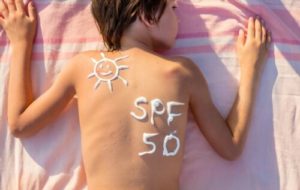 The recommended SPF for most people is 30, up to a maximum of 50. Do you know what is the difference between the SPFs? Not a lot, to be perfectly honest! SPF 30 blocks 97 percent of UVB rays and SPF 50 blocks 98 percent of UVB rays. Even SPF 15 blocks 93% of UVB rays. No sunscreen blocks 100% of UVB rays, and the higher the SPF of the chemical sunscreen, the greater amount of avobenzone or oxybenzone will be included in the ingredients, which are known hormone disruptors, and can cause organ system toxicity, skin allergies and photosensitivity. It is known that avobenzone degrades when exposed to the sun, and potentially results in harmful free radicals which can expedite premature ageing and even increase the risk of cancer. Oxybenzone is also not recommended during pregnancy or breastfeeding. Chemical sunscreens containing oxybenzone are banned either for sale or use in a number of places including Hawaii, Key West, parts of Mexico, U.S. Virgin Islands, Aruba, Bonaire and Palau as a result of coral damage including bleaching due to these chemicals. There are natural mineral alternatives which sit on the skin to deflect rays, rather than absorbing into the skin such as zinc oxide and titanium dioxide.
The recommended SPF for most people is 30, up to a maximum of 50. Do you know what is the difference between the SPFs? Not a lot, to be perfectly honest! SPF 30 blocks 97 percent of UVB rays and SPF 50 blocks 98 percent of UVB rays. Even SPF 15 blocks 93% of UVB rays. No sunscreen blocks 100% of UVB rays, and the higher the SPF of the chemical sunscreen, the greater amount of avobenzone or oxybenzone will be included in the ingredients, which are known hormone disruptors, and can cause organ system toxicity, skin allergies and photosensitivity. It is known that avobenzone degrades when exposed to the sun, and potentially results in harmful free radicals which can expedite premature ageing and even increase the risk of cancer. Oxybenzone is also not recommended during pregnancy or breastfeeding. Chemical sunscreens containing oxybenzone are banned either for sale or use in a number of places including Hawaii, Key West, parts of Mexico, U.S. Virgin Islands, Aruba, Bonaire and Palau as a result of coral damage including bleaching due to these chemicals. There are natural mineral alternatives which sit on the skin to deflect rays, rather than absorbing into the skin such as zinc oxide and titanium dioxide.
Overall whilst the consequences of sunburn far outweigh the possible side-effects of the chemicals contained within them, it is not recommended to exceed a factor 30-50 since it provides adequate protection, and the extra protection provided by higher factors is minimal and does not justify exposing the body to higher levels of these chemicals.
Just what the doctor ordered
 Whilst many are quick to point out the evils of sunbathing, let’s remember that the body needs some sunlight everyday for healthy functioning. Vitamin D, which is actually known as the sunshine vitamin, is not actually a vitamin but a hormone, or prohormone. It is essential to health, and although it can also be obtained through diet (egg yolk, cheese, fatty fish, mushrooms, beef liver, fortified milk and cereals) or supplements, the body naturally produces vitamin D as a response to UVB exposure. Just 15 minutes a day unprotected exposure in the sun is adequate for the average fair-skinned person to get all they need.
Whilst many are quick to point out the evils of sunbathing, let’s remember that the body needs some sunlight everyday for healthy functioning. Vitamin D, which is actually known as the sunshine vitamin, is not actually a vitamin but a hormone, or prohormone. It is essential to health, and although it can also be obtained through diet (egg yolk, cheese, fatty fish, mushrooms, beef liver, fortified milk and cereals) or supplements, the body naturally produces vitamin D as a response to UVB exposure. Just 15 minutes a day unprotected exposure in the sun is adequate for the average fair-skinned person to get all they need.
Vitamin D promotes calcium absorption in the intestines and helps regulate levels of calcium and phosphorus which are essential for healthy bones, teeth and muscles. A vitamin D deficiency can result in a loss of bone density, contributing to osteoporosis, fractures (broken bones), and bone pain (osteomalacia), whilst children can suffer from rickets, a disease which causes the bones to become soft and bend, and cause bone deformities. Additionally vitamin D supports the nervous and immune systems and helps to regulate inflammation. It is believed to reduce the risk of autoimmune diseases such as asthma, diabetes and arthritis. Low levels of vitamin D have been linked with allergies, asthma and eczema, and children living nearer to the equator have lower hospital admission rates for allergies, and less prescriptions for epi-pens since serious allergies, such as a peanut allergy, are much less prevalent. Vitamin D has also been associated with sleep quality, and is thought to help regulate the mood and decrease the risk of depression. Sun exposure is credited with increasing the release of serotonin, a neurotransmitter that is responsible for the feeling of satisfaction, happiness and optimism, and is otherwise known as the happy hormone.
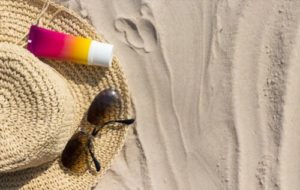 Therefore soaking in the sun may be just what the doctor ordered, as long as it is done responsibly. Just take care, and remember that when it comes to a safe (and great) tan, slow and easy wins the race every time. However, if you should make a mistake and misjudge your sun exposure, Mother Nature has some wonderful remedies to take the sting out of the burn for you.
Therefore soaking in the sun may be just what the doctor ordered, as long as it is done responsibly. Just take care, and remember that when it comes to a safe (and great) tan, slow and easy wins the race every time. However, if you should make a mistake and misjudge your sun exposure, Mother Nature has some wonderful remedies to take the sting out of the burn for you.
